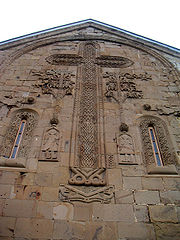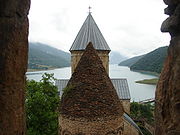
Ananuri
Encyclopedia



Castle
A castle is a type of fortified structure built in Europe and the Middle East during the Middle Ages by European nobility. Scholars debate the scope of the word castle, but usually consider it to be the private fortified residence of a lord or noble...
complex on the Aragvi River
Aragvi River
The Aragvi River and its basin is located in Georgia on the southern slope of the Caucasus Mountains. The river is 112 km in length. The basin covers an area 2,724 km² The ground strata is mostly sandstone, slate, and limestone. The hydro-electricity dam built on the river produces much of...
in Georgia
Georgia (country)
Georgia is a sovereign state in the Caucasus region of Eurasia. Located at the crossroads of Western Asia and Eastern Europe, it is bounded to the west by the Black Sea, to the north by Russia, to the southwest by Turkey, to the south by Armenia, and to the southeast by Azerbaijan. The capital of...
, about 45 miles from Tbilisi
Tbilisi
Tbilisi is the capital and the largest city of Georgia, lying on the banks of the Mt'k'vari River. The name is derived from an early Georgian form T'pilisi and it was officially known as Tiflis until 1936...
.
History
Ananuri was a castle and seat of the eristaviEristavi
Eristavi was a Georgian feudal office, roughly equivalent to the Byzantine strategos and normally translated into English as "duke". In the Georgian aristocratic hierarchy, it was the title of the third rank of prince and governor of a large province...
s (Duke
Duke
A duke or duchess is a member of the nobility, historically of highest rank below the monarch, and historically controlling a duchy...
s) of Aragvi
Duchy of Aragvi
The Duchy of Aragvi was an important fiefdom in medieval and early modern Georgia, strategically located in the upper Aragvi valley, in the foothills of the eastern Greater Caucasus crest, and ruled by a succession of eristavi from c...
, a feudal dynasty which ruled the area from the 13th century. The castle was the scene of numerous battles.
In 1739, Ananuri was attacked by forces from a rival duchy, commanded by Shanshe of Ksani and was set on fire. The Aragvi clan was massacred. However, four years later, the local peasants revolted against rule by the Shamshe, killing the usurpers and inviting King Teimuraz II
Teimuraz II
Teimuraz II , of the Bagrationi dynasty, was a king of Kakheti, eastern Georgia, from 1732 to 1744, then of Kartli from 1744 until his death.- Life :...
to rule directly over them. However, in 1746, King Teimuraz was forced to suppress another peasant uprising, with the help of King Erekle II
Erekle II
Erekle II was a Georgian monarch of the Bagrationi Dynasty, reigning as the king of Kakheti from 1744 to 1762, and of Kartli and Kakheti from 1762 until 1798. In the contemporary Persian sources he is referred to as Erekli Khan, while Russians knew him as Irakli...
of Kakheti
Kakheti
Kakheti is a historical province in Eastern Georgia inhabited by Kakhetians who speak a local dialect of Georgian. It is bordered by the small mountainous province of Tusheti and the Greater Caucasus mountain range to the north, Russian Federation to the Northeast, Azerbaijan to the Southeast, and...
. The fortress remained in use until the beginning of the 19th century. In 2007, the complex has been on the tentative list for inclusion into the UNESCO
UNESCO
The United Nations Educational, Scientific and Cultural Organization is a specialized agency of the United Nations...
World Heritage Site
World Heritage Site
A UNESCO World Heritage Site is a place that is listed by the UNESCO as of special cultural or physical significance...
program.
Architecture
The fortifications consist of two castles joined by a crenellated curtain wallCurtain wall (fortification)
A curtain wall is a defensive wall between two bastions of a castle or fortress.In earlier designs of castle the curtain walls were often built to a considerable height and were fronted by a ditch or moat to make assault difficult....
. The upper fortification with a large square tower, known as Sheupovari, is well-preserved and is the location of the last defense of the Aragvi against the Shamshe. The lower fortification, with a round tower, is mostly in ruins.
Within the complex, amongst other buildings, are two churches. The older Church of the Virgin, which abuts a tall square tower, has the graves of some of the Dukes of Aragvi. It dates from the first half of the 17th century, and was built of brick. The interior is no longer decorated, but of interest is a stone baldaquin erected by the widow of the Duke Edishera, who died in 1674.
The larger Church of the Assumption (Ghvtismshobeli), built in 1689 for the son of Duke Bardzem. It is a central dome style structure with richly decorated facades, including a carved north entrance and a carved grapevine cross
Grapevine cross
The Grapevine Cross also known as the Georgian cross or Saint Nino's cross, is a major symbol of the Georgian Orthodox Church, dating from the 4th century AD, when Christianity became an official religion in the kingdom of Iberia .It is recognisable by the slight drooping of its horizontal arms...
on the south façade. It also contains the remains of a number of fresco
Fresco
Fresco is any of several related mural painting types, executed on plaster on walls or ceilings. The word fresco comes from the Greek word affresca which derives from the Latin word for "fresh". Frescoes first developed in the ancient world and continued to be popular through the Renaissance...
es, most of which were destroyed by the fire in the 18th century.
External links
International Association of Tourists and Travelers

